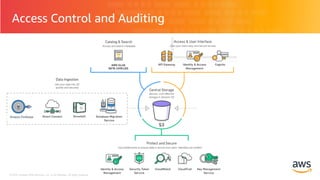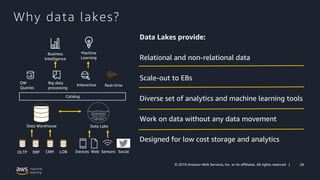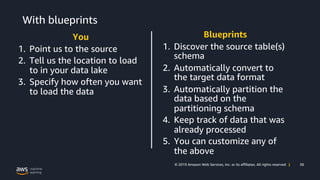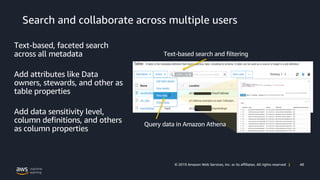Cutting to the chase for Machine Learning Analytics Ecosystem & AWS Lake Formation
- 1. 1© 2019 Amazon Web Services, Inc. or its affiliates. All rights reserved | 1© 2019 Amazon Web Services, Inc. or its affiliates. All rights reserved | Asif Abbasi – Specialist SA Analytics 03.Nov.2019 Cutting to the chase for Machine Learning Analytics Ecosystem & AWS Lake Formation @masifabbasi
- 2. 2© 2019 Amazon Web Services, Inc. or its affiliates. All rights reserved | Agenda • Analytics Ecosystem • Why did we build AWS Lake Formation? • What is AWS Lake Formation? • How does AWS Lake Formation help you?
- 3. © 2018, Amazon Web Services, Inc. or its Affiliates. All rights reserved. Analytics Value Stream idea insight COLLECT STORE PROCESS/ ANALYZE CONSUME time to first answer
- 4. © 2018, Amazon Web Services, Inc. or its Affiliates. All rights reserved. Agile Analytics • Experiment • Invest in and scale up success • Fail fast • Adapt and evolve rapidly
- 5. © 2018, Amazon Web Services, Inc. or its Affiliates. All rights reserved. A Modern Data Platform • Treat data as a reusable asset (while keeping the cost of reuse low) • Apply an open set of processing strategies in parallel
- 6. © 2018, Amazon Web Services, Inc. or its Affiliates. All rights reserved. Data Lake Store all your data, forever, at every stage of its lifecycle Apply it using the right tool for the job
- 7. © 2018, Amazon Web Services, Inc. or its Affiliates. All rights reserved.© 2018, Amazon Web Services, Inc. or its Affiliates. All rights reserved. Storage Foundations: Amazon S3
- 8. © 2018, Amazon Web Services, Inc. or its Affiliates. All rights reserved. Events and Lifecycle Management Standard Active data Archive dataInfrequently accessed data Standard - Infrequent Access Amazon Glacier Create Delete
- 9. © 2018, Amazon Web Services, Inc. or its Affiliates. All rights reserved. Benefits of Using S3 as Your Data Lake Foundation • Unlimited number of objects and volume • 99.99% availability • 99.999999999% durability • Versioning • Tiered storage via lifecycle policies • SSL, client/server-side encryption at rest • Low cost (~ $2700/month/100 TB) • Natively supported by big data frameworks (eg. Spark, Hive, Presto) • Decouples storage and compute • Run transient compute clusters (with Amazon EC2 Spot Instances) • Multiple, heterogeneous clusters can use same data
- 10. © 2018, Amazon Web Services, Inc. or its Affiliates. All rights reserved.© 2018, Amazon Web Services, Inc. or its Affiliates. All rights reserved. Ingest Kinesis Firehose
- 11. © 2018, Amazon Web Services, Inc. or its Affiliates. All rights reserved.© 2018, Amazon Web Services, Inc. or its Affiliates. All rights reserved. Data Catalog: Discover and Govern Your Data Kinesis Firehose
- 12. © 2018, Amazon Web Services, Inc. or its Affiliates. All rights reserved. Glue Data Catalog Hive metastore-compatible, highly-available metadata repository: • Search metadata for data discovery • Connection info – JDBC URLs, credentials • Classification for identifying and parsing files • Versioning of table metadata as schemas evolve and other metadata are updated • Table definitions – usable by Redshift, Athena, Glue, EMR Populate using Hive DDL, bulk import, or automatically through crawlers.
- 13. © 2018, Amazon Web Services, Inc. or its Affiliates. All rights reserved.© 2018, Amazon Web Services, Inc. or its Affiliates. All rights reserved. Catalog and Query Multiple Sources
- 14. © 2018, Amazon Web Services, Inc. or its Affiliates. All rights reserved.© 2018, Amazon Web Services, Inc. or its Affiliates. All rights reserved. Access Control and Auditing Kinesis Firehose
- 15. © 2018, Amazon Web Services, Inc. or its Affiliates. All rights reserved.© 2018, Amazon Web Services, Inc. or its Affiliates. All rights reserved. Access Control and Auditing IAM Amazon S3 Amazon DynamoDB Amazon EMR Amazon Kinesis Amazon Athena Service API Access AWS CloudTrail Identity and Access Management • Security at the API and data level 3rd party ecosystem security tools • Blue Talon, Apache Ranger, Sentry, etc Storage-level access logging and audit • AWS CloudTrail logs API calls • S3 access logging • Log analytics with Athena Encryption • AWS Server-Side Encryption • AWS Key Management Service • AWS CloudHSM • Custom materials providers
- 16. © 2018, Amazon Web Services, Inc. or its Affiliates. All rights reserved.© 2018, Amazon Web Services, Inc. or its Affiliates. All rights reserved. Process and Analyze Kinesis Firehose Athena Query Service
- 17. © 2018, Amazon Web Services, Inc. or its Affiliates. All rights reserved. Job Authoring with AWS Glue • Python/Scala code generated by AWS Glue • Connect a notebook or IDE to AWS Glue • Existing code brought into AWS Glue
- 18. © 2018, Amazon Web Services, Inc. or its Affiliates. All rights reserved. Job Execution with AWS Glue • Schedule-based • Event-based • On demand
- 19. © 2018, Amazon Web Services, Inc. or its Affiliates. All rights reserved. Serverless Queries: Amazon Athena • Interactive queries • ANSI SQL • No infrastructure or administration • Zero spin up time • Query data in its raw format • AVRO, Text, CSV, JSON, weblogs, AWS service logs • Convert to an optimized form like ORC or Parquet for the best performance and lowest cost • No loading of data, no ETL required • Stream data from directly from Amazon S3 • Take advantage of Amazon S3 durability and availability
- 20. © 2018, Amazon Web Services, Inc. or its Affiliates. All rights reserved.© 2018, Amazon Web Services, Inc. or its Affiliates. All rights reserved. Data Warehousing: Amazon Redshift Managed, massively parallel, petabyte-scale, relational data warehouse Scale from 160GB to 2PB online Automatic streaming backup/restore to S3, Automatic failover and recovery ANSI SQL interface Load data from S3, DynamoDB and EMR
- 21. © 2018, Amazon Web Services, Inc. or its Affiliates. All rights reserved.© 2018, Amazon Web Services, Inc. or its Affiliates. All rights reserved. Query Exabytes of Data: Redshift Spectrum Amazon Redshift JDBC/ODBC ... 1 2 3 4 N Amazon S3 Exabyte-scale object storage Data Catalog Apache Hive Metastore Run Amazon Redshift SQL queries against exabytes of data in Amazon S3
- 22. © 2018, Amazon Web Services, Inc. or its Affiliates. All rights reserved. Managed Hadoop Framework: Amazon EMR Scalable compute clusters as a service • Create ephemeral clusters – only pay for the compute you need • Integrated with S3 (EMRFS) • Use spot instances to reduce processing time AND costs • Dynamically scale up and down • Data encryption at-rest and in-transit
- 23. © 2018, Amazon Web Services, Inc. or its Affiliates. All rights reserved. Business Analytics Service: Amazon QuickSight Deep Integration with AWS Data Sources Amazon RDS, Aurora Amazon Redshift Amazon Athena Amazon S3 Flat Files • Fully managed • 1/10 cost of traditional BI solutions • Integrated with AWS data sources and third-party sources • SPICE – Super-fast, Parallel, In- memory, Calculation Engine • Collaborate, share and publish data sets and analyses
- 24. © 2018, Amazon Web Services, Inc. or its Affiliates. All rights reserved.© 2018, Amazon Web Services, Inc. or its Affiliates. All rights reserved. Building a Data Strategy on AWS Kinesis Firehose Athena Query Service
- 25. © 2018, Amazon Web Services, Inc. or its Affiliates. All rights reserved.© 2018, Amazon Web Services, Inc. or its Affiliates. All rights reserved. An Open Ecosystem of Applications Processing & Analytics BI & Data Visualization Kinesis Streams & Firehose Batch EMR Hadoop, Spark, Presto Redshift Data Warehouse Athena Query Service AWS Batch Predictive Real-time AWS Lambda Apache Storm on EMR Apache Flink on EMR Spark Streaming on EMR Elasticsearch Service Kinesis Analytics, Kinesis Streams EastiCache DAX Online/Transactional DynamoDB (NoSQL) Aurora (Relational) Neptun e (Graph)
- 26. 26© 2019 Amazon Web Services, Inc. or its affiliates. All rights reserved | 26© 2019 Amazon Web Services, Inc. or its affiliates. All rights reserved | Data Lakes
- 27. 27© 2019 Amazon Web Services, Inc. or its affiliates. All rights reserved | A data lake is a centralized repository that allows you to store all your structured and unstructured data at any scale
- 28. 28© 2019 Amazon Web Services, Inc. or its affiliates. All rights reserved | Why data lakes? Data Lakes provide: Relational and non-relational data Scale-out to EBs Diverse set of analytics and machine learning tools Work on data without any data movement Designed for low cost storage and analytics OLTP ERP CRM LOB Data Warehouse Business Intelligence Data Lake 1001100001001010111 0010101011100101010 0001011111011010 0011110010110010110 0100011000010 Devices Web Sensors Social Catalog Machine Learning DW Queries Big data processing Interactive Real-time
- 29. 29© 2019 Amazon Web Services, Inc. or its affiliates. All rights reserved | Any analytic workload, any scale, at the lowest possible cost AWS Direct Connect AWS Snowball AWS Snowmobile AWS Database Migration Service AWS IoT Core Amazon Kinesis Data Firehose Amazon Kinesis Data Streams Amazon Kinesis Video Streams On-premises Data Movement Amazon SageMaker AWS Deep Learning AMIs Amazon Rekognition Amazon Lex AWS DeepLens Amazon Comprehend Amazon Translate Amazon Transcribe Amazon Polly Amazon Athena Amazon EMR Amazon Redshift Amazon Elasticsearch Service Amazon Kinesis Amazon QuickSight Analytics Machine Learning Real-time Data Movement
- 30. 30© 2019 Amazon Web Services, Inc. or its affiliates. All rights reserved | Typical steps of building a data lake Setup storage1 Move data2 Cleanse, prep, and catalog data 3 Configure and enforce security and compliance policies 4 Make data available for analytics 5
- 31. 31© 2019 Amazon Web Services, Inc. or its affiliates. All rights reserved | Building data lakes can still take months
- 32. 32© 2019 Amazon Web Services, Inc. or its affiliates. All rights reserved | Data preparation accounts for ~80% of the work Building training sets Cleaning and organizing data Collecting data sets Mining data for patterns Refining algorithms Other
- 33. 33© 2019 Amazon Web Services, Inc. or its affiliates. All rights reserved | Sample of steps required Find sources Create Amazon Simple Storage Service (Amazon S3) locations Configure access policies Map tables to Amazon S3 locations ETL jobs to load and clean data Create metadata access policies Configure access from analytics services Rinse and repeat for other: data sets, users, and end-services And more: manage and monitor ETL jobs update metadata catalog as data changes update policies across services as users and permissions change manually maintain cleansing scripts create audit processes for compliance … Manual | Error-prone | Time consuming
- 34. 34© 2019 Amazon Web Services, Inc. or its affiliates. All rights reserved | Enforce security policies across multiple services Gain and manage new insights Identify, ingest, clean, and transform data Build a secure data lake in days AWS Lake Formation
- 35. 35© 2019 Amazon Web Services, Inc. or its affiliates. All rights reserved | How it works
- 36. 36© 2019 Amazon Web Services, Inc. or its affiliates. All rights reserved | Register existing data or import new Amazon S3 forms the storage layer for Lake Formation Register existing S3 buckets that contain your data Ask Lake Formation to create required S3 buckets and import data into them Data is stored in your account. You have direct access to it. No lock-in. Data Lake Storage Data Catalog Access Control Data import Lake Formation Crawlers ML-based data prep
- 37. 37© 2019 Amazon Web Services, Inc. or its affiliates. All rights reserved | Easily load data to your data lake logs DBs Blueprints Data Lake Storage Data Catalog Access Control Data import Lake Formation Crawlers ML-based data prep one-shot incremental
- 38. 38© 2019 Amazon Web Services, Inc. or its affiliates. All rights reserved | With blueprints You 1. Point us to the source 2. Tell us the location to load to in your data lake 3. Specify how often you want to load the data Blueprints 1. Discover the source table(s) schema 2. Automatically convert to the target data format 3. Automatically partition the data based on the partitioning schema 4. Keep track of data that was already processed 5. You can customize any of the above
- 39. 39© 2019 Amazon Web Services, Inc. or its affiliates. All rights reserved | Blueprints build on AWS Glue
- 40. 40© 2019 Amazon Web Services, Inc. or its affiliates. All rights reserved | Easily de-duplicate your data with ML transforms
- 41. 41© 2019 Amazon Web Services, Inc. or its affiliates. All rights reserved | Fuzzy de-duplication – under the hood
- 42. 42© 2019 Amazon Web Services, Inc. or its affiliates. All rights reserved | Fuzzy de-duplication – Innovations 400M+ 7.5B+ 2.5
- 43. 43© 2019 Amazon Web Services, Inc. or its affiliates. All rights reserved | Secure once, access in multiple ways Data Lake Storage Data Catalog Access Control Lake Formation Admin
- 44. 44© 2019 Amazon Web Services, Inc. or its affiliates. All rights reserved | Security permissions in Lake Formation Control data access with simple grant and revoke permissions Specify permissions on tables and columns rather than on buckets and objects Easily view policies granted to a particular user Audit all data access at one place
- 45. 45© 2019 Amazon Web Services, Inc. or its affiliates. All rights reserved | Security permissions in Lake Formation Search and view permissions granted to a user, role, or group in one place Verify permissions granted to a user Easily revoke policies for a user
- 46. 46© 2019 Amazon Web Services, Inc. or its affiliates. All rights reserved | Grant table and column-level permissions User 1 User 2
- 47. 47© 2019 Amazon Web Services, Inc. or its affiliates. All rights reserved | Security – deep dive User IAM users, roles Active Directory Amazon S3
- 48. 48© 2019 Amazon Web Services, Inc. or its affiliates. All rights reserved | Search and collaborate across multiple users Text-based, faceted search across all metadata Add attributes like Data owners, stewards, and other as table properties Add data sensitivity level, column definitions, and others as column properties Text-based search and filtering Query data in Amazon Athena
- 49. 49© 2019 Amazon Web Services, Inc. or its affiliates. All rights reserved | Audit and monitor in real time See detailed alerts in the console Download audit logs for further analytics Data ingest and catalog notifications also published to Amazon CloudWatch events
- 50. 50© 2019 Amazon Web Services, Inc. or its affiliates. All rights reserved | Example: a data lake in 3 easy steps
- 51. 51© 2019 Amazon Web Services, Inc. or its affiliates. All rights reserved | Step 1: Blueprints to ingest data
- 52. 52© 2019 Amazon Web Services, Inc. or its affiliates. All rights reserved | Monitor the import 1
- 53. 53© 2019 Amazon Web Services, Inc. or its affiliates. All rights reserved | Imported data as table in the data lake
- 54. 54© 2019 Amazon Web Services, Inc. or its affiliates. All rights reserved | Step 2: Grant permissions to securely share data
- 55. 55© 2019 Amazon Web Services, Inc. or its affiliates. All rights reserved | Step 3: Run query in Amazon Athena
- 56. 56© 2019 Amazon Web Services, Inc. or its affiliates. All rights reserved | AWS Lake Formation Pricing No additional charges – Only pay for the underlying services used.
- 57. 57© 2019 Amazon Web Services, Inc. or its affiliates. All rights reserved | Customer interest “We are very excited about the launch of AWS Lake Formation, which provides a central point of control to easily load, clean, secure, and catalog data from thousands of clients to our AWS-based data lake, dramatically reducing our operational load. … Additionally, AWS Lake Formation will be HIPAA compliant from day one …” Aaron Symanski, CTO, Change Healthcare “I can’t wait for my team to get our hands on AWS Lake Formation. With an enterprise-ready option like Lake Formation, we will be able to spend more time deriving value from our data rather than doing the heavy lifting involved in manually setting up and managing our data lake.” Joshua Couch, VP Engineering, Fender Digital
- 58. 58© 2019 Amazon Web Services, Inc. or its affiliates. All rights reserved | Thank you!


























































